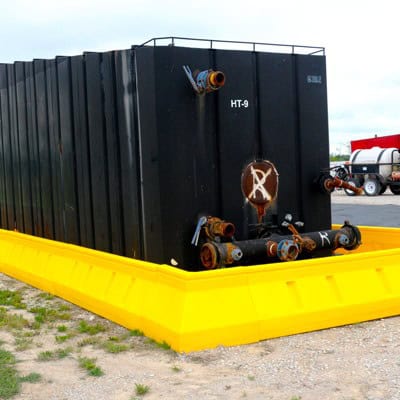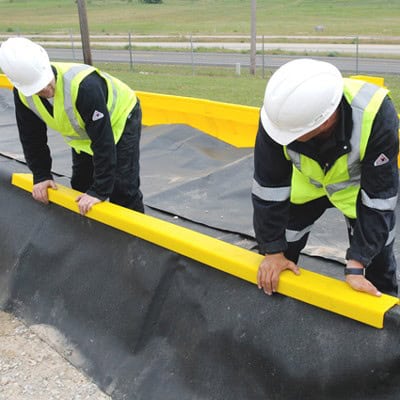In today’s world, businesses must prioritize environmental responsibility. One key aspect of this responsibility is managing spills and leaks, which can have severe consequences for both the environment and a company’s bottom line. Spill berms are an effective solution for containing spills, but understanding and complying with environmental regulations can be challenging. In this article, we’ll explore the importance of spill berms, delve into the relevant EPA regulations, and provide guidance on achieving compliance.
Understanding Spill Berms
Spill berms are containment systems designed to prevent hazardous materials from spreading during a spill. They are often used in industries such as manufacturing, transportation, and oil and gas to contain liquids like chemicals, oils, and fuels. By containing spills, spill berms help protect the environment and reduce cleanup costs.

Types of Spill Berms
There are various types of spill berms to suit different needs:
- Drive-over Berms: These are robust enough to allow vehicles to pass over them without causing damage. They are commonly used in areas with frequent vehicle traffic.
- Portable Berms: Lightweight and easy to deploy, these berms are ideal for temporary or emergency use.
- Custom Berms: Tailored to specific requirements, custom berms provide a perfect fit for unique spaces or applications.
Choosing the right type of spill berm depends on the specific requirements of your operation.
The Importance of Compliance
Failing to comply with environmental regulations can result in hefty fines and damage to a company’s reputation. Compliance ensures that businesses operate safely and responsibly, protecting both the environment and public health.
EPA Regulations Overview
The Environmental Protection Agency (EPA) sets regulations to control and reduce pollution. These regulations are vital for maintaining a clean and safe environment. Businesses must adhere to these rules to minimize their environmental impact.
Key EPA Regulations for Spill Management
- Spill Prevention, Control, and Countermeasure (SPCC) Rule: This regulation aims to prevent oil spills from reaching navigable waters. Facilities storing significant amounts of oil must have an SPCC plan in place.
- Resource Conservation and Recovery Act (RCRA): This law governs the disposal of hazardous waste. Companies must manage their waste in a way that prevents spills and contamination.
- Clean Water Act (CWA): Under this act, businesses must prevent pollution from entering waterways. Spill berms are an effective tool for meeting these requirements.
Achieving Compliance with Spill Berms
To ensure compliance with EPA regulations, businesses should take proactive measures to manage spills effectively. Here are some steps to help achieve compliance:
Conduct a Risk Assessment
Start by assessing the risks associated with your operations. Identify potential spill sources and evaluate the likelihood and impact of a spill. This assessment will guide your spill management strategy.
Develop a Spill Response Plan
A well-crafted spill response plan outlines the steps to take in the event of a spill. It should include:
- Roles and Responsibilities: Assign specific roles for spill response, ensuring everyone knows their duties.
- Emergency Contacts: Compile a list of emergency contacts, including local authorities and cleanup contractors.
- Response Procedures: Detail the steps to contain and clean up spills safely and efficiently.
Invest in Spill Containment Solutions
Choose the right spill berms and other containment solutions for your needs. Consider factors such as the type of materials you handle, the size of potential spills, and the frequency of spills.
Train Employees
Ensure that employees are trained in spill response procedures and the use of spill containment equipment. Regular drills and training sessions can help reinforce these practices and improve response times.
Monitor and Maintain Equipment
Regularly inspect spill berms and other containment equipment to ensure they are in good working condition. Replace damaged or worn-out equipment promptly to maintain compliance.

Common Compliance Challenges
Despite the best efforts, businesses may face challenges in achieving compliance. Here are some common obstacles and tips for overcoming them:
Keeping Up with Regulation Changes
Environmental regulations can change frequently. Stay informed by subscribing to industry newsletters, attending workshops, and consulting with environmental experts.
Balancing Costs and Compliance
Implementing compliance measures can be costly, but non-compliance can be even more expensive. Prioritize investments in spill containment and response equipment to mitigate risks and avoid fines.
Managing Multiple Locations
For businesses with multiple facilities, ensuring consistent compliance across all locations can be challenging. Consider appointing compliance officers at each site to oversee spill management efforts.
The Benefits of Compliance
While achieving compliance requires effort and investment, the benefits far outweigh the costs. Complying with environmental regulations can lead to:
- Reduced Liability: By preventing spills, businesses can avoid costly fines and legal action.
- Enhanced Reputation: Demonstrating environmental responsibility can improve a company’s reputation and attract eco-conscious customers.
- Operational Efficiency: Implementing spill management strategies can streamline operations and reduce waste.
Conclusion
Navigating environmental regulations can be daunting, but with the right approach, businesses can achieve compliance and contribute to a cleaner, safer world. By understanding the importance of spill berms, familiarizing themselves with EPA regulations, and implementing effective spill management strategies, businesses can protect the environment and their bottom line. Remember, compliance is not just a legal requirement; it’s a commitment to environmental stewardship.
Safeguard Your Operations: Invest in Spill Containment Today!
Don’t wait until an incident occurs to address spill containment in your operations. Protect your business, the environment, and your reputation by investing in high-quality spill containment berms. Visit Absorbents Online to explore our comprehensive selection of spill berms designed to meet a variety of needs. With competitive pricing and expert customer service, we provide the solutions you need to ensure compliance and peace of mind. Act now to safeguard your operations and demonstrate your commitment to environmental responsibility.